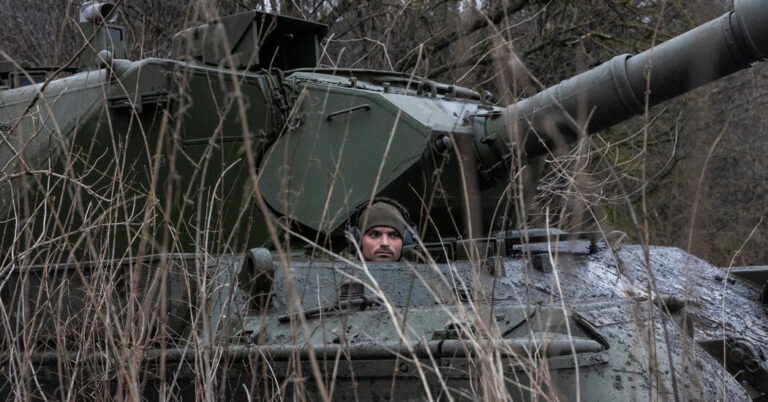OUR ENEMIES WILL VANISH: The Russian Invasion and Ukraine’s War of Independence, by Yaroslav Trofimov
“Kyiv was still a city at peace,” Yaroslav Trofimov writes about the afternoon of Feb. 23, 2022, the day before Russian forces invaded Ukraine. The sun was shining, the bars were full; he saw no scenes of panic buying at the shops or snaking lines at the A.T.M.s.
But like the title of his new book, “Our Enemies Will Vanish,” Trofimov’s depiction of an idyllic Kyiv only emphasizes the brutal realities of the ensuing war. Trofimov is the chief foreign-affairs correspondent at The Wall Street Journal and the author of two previous books, “Faith at War” (2005) and “The Siege of Mecca” (2007). This time, as a Kyiv native, he has an intensely personal connection to his subject.
“It felt wrong to wear on the streets of my own hometown the vest and the helmet that I had donned hundreds of times in Iraq, Afghanistan and other war zones,” Trofimov writes, driving past locations from his Soviet-era adolescence, including the cinema where he watched Fellini films and the botanical garden where he had his first kiss.
Long before the invasion, Vladimir Putin had depicted Ukraine as an “artificial” country that ultimately belonged to Russia. His territorial ambitions were further inflamed during the pandemic, when he spent months of self-isolation “reading the wrong history books,” as Trofimov acerbically puts it. (Trofimov has yet another personal connection to Putin’s war: His colleague, Evan Gershkovich, has been detained by Russia for nearly 300 days, awaiting trial on charges of espionage that The Wall Street Journal and the American government steadfastly deny.) Trofimov is candid about his own feelings of outrage toward Russian forces: “How dare they, I thought.”
“Our Enemies Will Vanish” is clearly not an outsider’s account, though as an experienced reporter, Trofimov mostly avoids the twin temptations of personalizing and pontificating, instead hewing closely to what he sees. He also provides some requisite historical context. The real start date of the war, he says, was eight years before the 2022 invasion, in 2014, when Putin declared that eastern and southern Ukraine should be known as Novorossiya, or “New Russia,” and seized control of Crimea and Donbas.
From those early victories, Putin took the wrong lesson. In 2022, Moscow expected to wrap up the whole operation in 10 days — which might very well have happened, had Putin been satisfied with restricting Russian efforts to eastern Ukraine, instead of setting his sights on the entire country.
A limited war “would have likely elicited only limited Western reaction,” Trofimov writes. “It could have also been won relatively quickly, causing a political crisis in Kyiv and a possible collapse” of the Ukrainian government under Volodymyr Zelensky. Ukrainian forces had spent the eight years since 2014 getting better training and improving discipline; they also established the Territorial Defense, made up of volunteers pledging to protect their local communities.
By contrast, Russian hubris meant that “even relatively minor obstacles forced them to pause,” Trofimov writes. Moscow had assumed that capturing the northeastern city of Kharkiv would be so easy that many of the Russian troops had brought their parade uniforms. Instead of being greeted as liberators, they were resisted as invaders, and so the Russian military unleashed its fury. In March 2022, Trofimov arrived to find the city “eviscerated.”
Most of the book chronicles his travels throughout Ukraine during the first year of the war, lingering especially on the chaos of those early weeks. He had to prove his identity to some fellow Ukrainians by saying the word for a bread that Russians apparently have a hard time pronouncing. Staring down the Kalashnikovs of screaming police officers, he made a video call to an interior ministry official who vouched that Trofimov was not a Russian spy. As the war ground on, artifacts of a thriving economy began to look like cruel taunts. Amid the wreckage of Kharkiv, “decapitated mannequins spilled out of windows,” and a Nike billboard boasted, “We planned for everything.”
The book is divided into 48 chapters spread out over 11 parts; such fragmentation is a sign that the story Trofimov is telling is still unfolding, its arc still unclear. Most of the Ukrainians he quotes are adamant about repelling the Russian invasion, including some who had been supporters of Putin’s Russia before February 2022. One Russian-speaking mayor of a Ukrainian town scoffs at “the Russians and their imperial mania of greatness.” But Trofimov also meets Ukrainians living in places where “the Russian takeover had been quick and painless,” whose lives were severely disrupted only after the occupiers withdrew.
The desire for stability is a constant, Trofimov finds, fueling fearful collaboration with the Russians in some cases and fierce resistance in others. A morgue attendant in Mykolaiv, a city near the Black Sea, gestures at a pile of cadavers brought back from the front line. “Now we can go to a shop that is full of goods or buy a cup of tea,” he tells Trofimov. “We are free to walk the streets.” His point is that the return of ordinary pleasures is a hard-won victory. But it is also provisional. Trofimov describes a bustling promenade in one paragraph and bodies being pulled out of the rubble in the next.
The book’s title is a line from Ukraine’s national anthem: “Our enemies will vanish/Like dew at sunrise.” Trofimov clings to this rousing sentiment, even if the war reporter in him is constantly reminded that conflicts never work out that way. “A long, grueling fight lay ahead,” he writes at the very end of the book. It’s a sober, plain-spoken assessment that doesn’t tell us all that much — which is also what makes it honest.
OUR ENEMIES WILL VANISH: The Russian Invasion and Ukraine’s War of Independence | By Yaroslav Trofimov | Penguin Press | 385 pp. | $32

